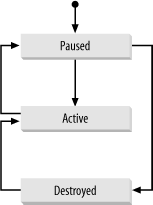More About MIDlets
In Chapter 1, we introduced you to MIDlets, applications that run on MIDP devices. MIDlets are written as one or more Java classes whose objects are compressed into a JAR file. Like Java applets, MIDP applications have an application life cycle while running on a mobile device. Specifically, a MIDlet can be in one of three states:
Paused
Active
Destroyed
Figure 3-1 shows the rules for transitioning between states.

Figure 3-1. MIDlet transition states
Here is a quick rundown of how MIDP applications change state: when a MIDlet is first started, it is placed in the paused state. After it’s ready, the controlling software will then place the MIDlet in the active state. At this point, the MIDlet is running and the user can interact with it. The application can be placed back in the paused state by either the MIDP system or the program itself. In addition, the MIDP can be moved to the destroyed state from either the paused or the active state, again by either the MIDP system or the programmer. In the destroyed state, the MIDlet should release all of the resources it currently has back to the MIDP system.
We’ll cover this in more detail in the following chapter, where we create and execute a MIDlet with multiple states. In the meantime, this quick introduction brings us to the point where we must first introduce some important concepts.
What Is a MIDlet Suite?
A MIDlet ...
Get Wireless Java now with the O’Reilly learning platform.
O’Reilly members experience books, live events, courses curated by job role, and more from O’Reilly and nearly 200 top publishers.

